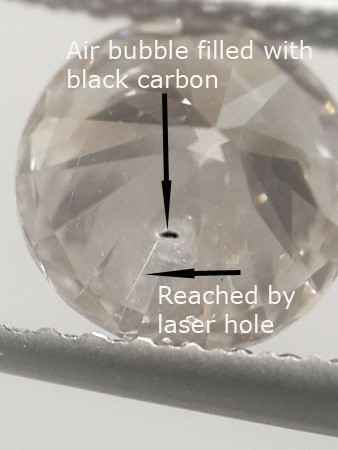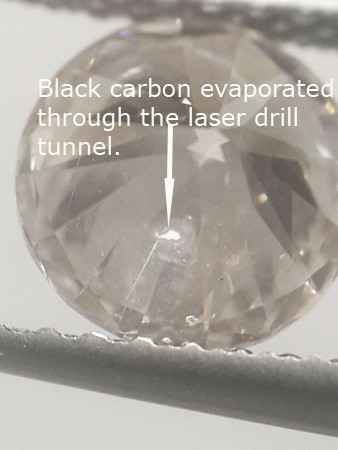Laser drilling diamond clarity enhancement
Monday, December 17, 2018
The Second Type of Enhancement-Laser drilling, an irreversible process
At the start of this article, I mentioned that aside from fracture filling, there are other kinds of enhancements too, of which one in particular deserves special mention in this context. The laser treatment is the second most popular type of enhancement for diamonds. Laser treatment is permanent, and therefore it last through the life of a stone. The scope of leaser treatment is much wider than fracture filling. In fracture filling, feathers inside diamonds that are visible to the eye are addressed, whereas through laser, black inclusions that are obvious to the eyes too can be treated. The before and after shots is proof of how well the enhancement works to remove carbon bubbles and such blemishes from visibility.
Through laser treatment, carbon residues from deep inside diamonds can be easily extracted out. Once free from the carbon content, the bubbles turn transparent or white and therefore less visible. This clarity enhancing technique is very precise, and all it leaves behind is a white trail. If you examine a laser enhanced stone under microscope, you will see nothing more than the tunnels through which the laser beam made its way into the crystal. After the laser hits the bubble, the crystal is moved into a high pressure chamber where it is treated with strong acids that dissolve the carbon dot and flush it out through the laser tunnel.
See pictures 1 and 2 below where the diamond has a black carbon filled internal bubble, we reach it by a laser drill, picture 6 below shows the black imperfection now being white.

Picture 1: Carbon spot too visible

Picture 2: Black Carbon extracted from diamond
Points to Note:
There are twin things about laser treated diamond that you want to bear in mind before going out and grabbing one.
· Unlike fracture filled diamonds, GIA makes lab reports for laser treated diamonds, which makes them globally acceptable.
· Legally, a jeweler is not obliged to inform a buyer about laser treated diamonds. That is according to FTC. But if you like to learn little details about your big purchases, do not hesitate to ask.
What Causes GIA to Certify One Kind of Enhancement and Not the Other?
It is obvious to wonder why will this trusted diamond laboratory certify for laser treatment diamonds and not for fracture filled kinds. The primary reason for that is accuracy. The association is not able to determine the diamond grades accurately before and after enhancements. That makes the reports apocryphal, because what seems eye-clean on the face turns vividly imperfect on scrutiny under magnification.
How Can a Buyer Detect a Laser Enhanced Diamond?
There are some ways of doing that. Some laser treatments are too obvious and you don’t really need a scope to tell. But, some are very difficult to detect. The obviousness of the signs depends on the depth and point of drilling. When observed face up, you can barely detect any signs of treatment in a diamond. This is because drilling is always done perpendicular to the concerned face of an inclusion. So when observed face up, the tunnels look like a pin prick that can be easily mistaken for a minor inclusion.
But, when you tilt the stone, the picture is very different. You can not only see the entry point of the drilling, but the entire tunnel, if you look carefully. The pictures 5 and 6 above shows the marks of a laser treated diamond. This is how it looks when put under a microscope. But from top, a laser treated diamond is perfectly clean and free of inclusions.
![Black Friday Sale]()




 ​
​